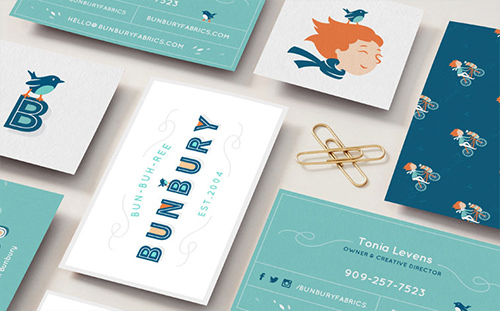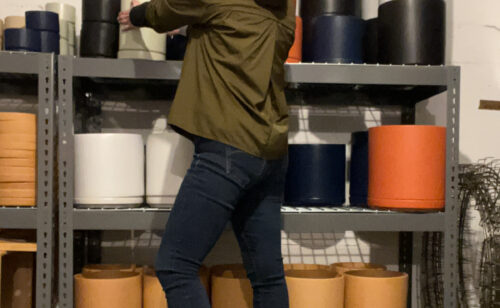14 Businesses Share How to Differentiate Your Brand

Yesterday, we talked about what to do next when you’re seeing success with your product-based business, and you want to increase your online sales. What if you’re not yet seeing success? What if you’re feeling unsure about your product, your brand, and who your customers are? If so, now is not the time to throw money at the problem. Now is the time to reevaluate what you’re doing, make sure that you’re on the right track, and differentiate your brand.
Today I’ve gathered some thoughts and resources for you on how to differentiate your brand and products from everything else in the world out there. It can be a challenging task! I think about this all the time, and my attention to this was recently sparked by Kristen from Worthwhile Paper’s post on the topic for her business.
“When I began the process of starting my own design/product-based business I got stumped by a question I saw somewhere: “What makes your products unique?” I didn’t have a definite answer for that question on the spot, and that was a huge problem for me! I quickly started thinking about what makes my products unique. They are screen printed, but that isn’t the only thing I have that makes them totally unique. We use recycled paper, but so do a lot of people. My designs are hand made and hand lettered, but I’m not the only one making hand made designs. I decided that while the combination of those things make my products special, what really makes them special is the intention behind the design, alongside my personal aesthetic style.”
• • • • •
Three adjectives to define your brand
Kristen linked to an oldie but very goodie by Emily McDowell on defining your brand:
“My three adjectives are: Insightful, Relatable, Colorful.
You have to be willing to kill even your favorite ideas if they don’t fit the adjectives, because if an idea doesn’t fit, it’s not right for your brand. I’m not gonna lie, this hurts, like finding a pair of pants that make your butt look awesome and leaving them behind in the dressing room. But ultimately, “because I like it” is not a good enough reason to add something to your line. If you’re going to build a cohesive, successful brand, you’ll need to consider your product ideas more strategically.”
• • • • •
Who are you selling to?
Stacia and Robert Guzzo were struggling with their brand when they realized that the people who were buying from them were not the people they’d been trying to sell to. They shifted everything and re-branded their business to appeal to the people who were actually shopping.
“The customer that we had been targeting this whole time was decidedly not the customer that we had actually been serving. Because our understanding of the customer was flawed, the problem that we were solving for that customer was very different from the problem we thought we were solving.
Our current brand was failing to resonate with the customer we had targeted, but it was also failing to effectively serve the customer we were actually reaching.”
Read more here: 11 Big Lessons From Handcrafted HoneyBee’s Transformative Rebrand
• • • • •
Start narrow and grow wide
Shopify shared an interesting post about this:
“There’s a common myth that crafting a successful niche marketing campaign is all about finding as small of an audience as possible and then creating a strategy that only serves that audience.
In reality, the secret to building an effective campaign is uncovering an underserved niche market and then creating a strategy that makes everyone want to be a part of that niche. It’s about creating a vision of your ideal customer and then motivating your audience to take ownership over that identity for themselves.“
Read this one here: How to use niche marketing to build a business from the ground up.
• • • • •
What if your product is the problem?
Abby Glassenberg notices that people are reluctant to advise others when a product isn’t going to be viable.
“We’re so lucky to have a tremendously supportive online community of makers today. When someone expresses disappointment that their product isn’t selling on Etsy we’re eager to help, pointing them to resources for improving their product shots or writing better listings or improving SEO. And of course all of those things are vital to having a successful handmade business online. But there are times when the crux of the problem is the product itself.
Some handmade items are incredibly time-consuming to create and have to be priced higher than the market can bear. And sometimes the handmade item itself is not made in a quality way or with quality materials. I think there’s a market out there for almost everything, but that market might be so small that it can’t sustain a business. Or it might be very difficult to reach.”
Read more here: When the product is the problem (the comments are very helpful, too)
• • • • •
Who is your product for?
And another great one, an interview with Brandy Davis of Pigsey Art on Academy of Handmade:
“If you ever find yourself answering the question “Who is your product for?” with “Everyone,” or the similar “Everyone with a baby/wedding/skeleton.” Full Stop. Aside from Death and Taxes, nothing is for everyone. […] Customers who feel like your product is for just anyone don’t feel the urgency to purchase. They need it to feel that this wood journal was MADE for their lifestyle, as if I was in their head giving them something they didn’t even know they needed or wanted but by hell if they’re not gonna have it.”
• • • • •
Discovering your unique selling proposition
Kristen also mentioned my post that helps you dig into the nitty gritty of your brand:
“Those businesses that seem to have had an overnight success and barely needed to work at promotion? There is something special about them. They know it and their customers know it. Their work can be spotted from a mile off, it’s something that people want, and it’s easy to promote – like a snowball rolling down hill, gathering speed, and getting huge.
Why is it so easy for them? If you have what they have, it will be easy for you, too. If you’re lacking this, it will be like trying to win a race with a bicycle that has square wheels. A crazy amount of work, with few results.”
Make magic for your business with a unique selling proposition.
• • • • •
Listen to what people really want
Tara Gentile explains that this is all about your customer, not about you:
“Don’t stop until you know how your differentiating factor leads your customers to more money, more time, better relationships, better health, etc… If you can’t boil it down to a simple, tangible benefit like that, you’re not done. What your customers truly care about is quite simple.
You have to listen to what people really want. You need to use their words, not yours. And, when the benefit they really want (more money, more time, better relationships, better health, etc…) sounds like what “everyone else is offering” push past your discomfort with that. In many ways, what you’re offering is the same as what everyone else is offering. Embrace that. Then use your unique process, point of view, voice, or advantage to differentiate.
When you push past the discomfort that what everyone else is selling is exactly what you’re selling too, you can finally get to a place where leveraging your difference really comes in handy.”
Read the rest here: “Look at me” versus “look at you”
• • • • •
Creating something worth talking about
Seth Godin breaks it down – why differentiation isn’t what you want:
“Remarkable has nothing to do with the marketer. Remarkable is in the eye of the consumer, the person who ‘remarks.’ If people talk about what you’re doing, it’s remarkable, by definition.
The goal, then, isn’t to draw some positioning charts and announce that you have differentiated your product. No, the opportunity is to actually create something that people choose to talk about, regardless of what the competition is doing.
Read the whole post here: Different or remarkable?
• • • • •
What could you be famous for?
Mei Pak explores the difficulties surrounding handmade or Made in the USA products, and how to avoid them by differentiating your business:
“Another deceivingly simple exercise you can do is to find out what one thing your shop can be famous for.
Famous actors, musicians, chefs, politicians and athletes are known for one specific thing that they do well at a genius level.
Sure, you can become famous for a few different things, but we all start with just one.
Do one thing better than everyone else in the market.”
Read this one here: How to find what makes your brand unique + why handmade and made in the USA is no longer enough
• • • • •
One company can not be everything to everyone
Kristen Ley of Thimblepress examines how to do something special for your own customers, and provides worksheets:
“The final thing I want to talk about is standing out amongst a sea of competitors that already do the same thing as you, well, at least on the surface. This is not a moment for you to go look at all your competitors, cry, and tell yourself you are not good enough. SHUT THAT DOOR, DUDE. This is a moment for you to be a smart business owner and realize that if you don’t take a minute to analyze your competitors because you believe you have none, you just may not get to where you want to grow your business.
If you know me, you know I am very open and share. The statement I always use is that there is enough business for everyone, and that is beyond true. There are millions upon millions of people in this world capable of buying 1 million different stationery companies’ products. I view my competition as people to learn from, look up to, and position around.
One company can not be everything to everyone. Look, even Apple can’t. SHOCKER! There are those dedicated PC users that WILL NEVER switch. The reason I bring all of this up is because look at your competitors, what key features they are providing and ones that you are providing? How can you stand out? I have a competitor analysis sheet in the worksheet to see how you can figure out key buying features to promote that maybe your competitors aren’t and help position yourself in a more unique way!”
You can read this full post here: Biz tip Tuesday: positioning and target markets
• • • • •
Avoid bargain pricing with a value proposition
Erica Gellerman explains:
“When scouring the Internet, it can look like everyone is creating the same thing you are. Competition is fierce and differentiation is difficult. When you’re busy comparing yourself to others, most people often default to comparing themselves on price. But by focusing on price, you’re missing the bigger business-building picture and you risk turning your well loved brand into a commodity. And nothing can kill a business faster than a race to the (pricing) bottom.
What can we do to avoid this bargain basement pricing scenario? Keep a clear focus on the value you are providing to the customer by creating a value proposition. A value proposition isn’t something you explicitly share with the customer, but is a guide for you, the business owner, as you continue to create, innovate, and grow your business. It keeps you focused on what matters to the customer and how you are meeting or exceeding that need with your business.”
• • • • •
When others zig, you zag
Ramit Sethi explains why you can’t afford to be doing what everyone else is online.
“When you’re the same as everyone else, you might as well not exist. It doesn’t matter if you’re a man, a woman, a life coach, a stylist, an analytics guru, or a language tutor. Whether you’re trying to get a date or start an online business, if you’re the same as everyone, you’re doomed.
No matter how beautiful your website is. No matter how exceptional your guarantee is. No matter how much you care.
This is where the concept of ZIGGING and ZAGGING comes in.
Where others zig, you zag.”
The rest of this one can be found here: The Zig/Zag Technique to finding an online business idea
• • • • •
Finding your winning difference
Shopify have some solid beginner information on this topic:
“However, after some market research you realize that a potential consumer has dozens if not hundreds of other online destinations they could choose instead of you. So, then why would they buy from you? That’s the question you need to answer as you start formulating your unique selling proposition.
There’s got to be something about what you do that helps you stand out from the pack, otherwise, how are you ever going to stay in business? Call it “positioning”, “differentiation”, “mission statement”, “vision statement”, or insert any other business terminology in there and it all comes down to the same thing. Why would a customer choose you and not a competitor?”
Read the rest of this post here: Why your online store needs a unique selling proposition (USP) to thrive
• • • • •
How can you differentiate your brand?
What makes a promising product or concept for an online shop?
- You are solving a problem for your customer
- You provide something your customers can only get from you
- Your product is recognizable as yours, even if customers see it out of context
- A standard of quality and price point that allows your business to be financially sustainable
- There is a market for your product, and you know who it is
- Your products and brand are consistent and make sense under a single umbrella
What did I miss? Please comment here with your thoughts!
A Newsletter That Goes Beyond Shopify 101
It’s easy to find beginner info about ecommerce online. If you’re past that? Subscribe to our newsletter for advanced strategies and need-to-know info for established shops. You'll get:
- Weekly tips to help you market and sell your products
- Updates when there is news that may impact your site
- Round ups of interesting links and info for brands
- Invites to our live trainings and webinars
- Instant access to our past emails
Browse Posts
A Newsletter That Goes Beyond Shopify 101
It’s easy to find beginner info about ecommerce online. If you’re past that? Subscribe to our newsletter for advanced strategies and need-to-know info for established shops.
Learn how the top shops grow:
"*" indicates required fields
Related Posts
Let's take your online shop to the next level
The Shopify websites we design have a reputation for substantial improvements to ecommerce conversion rates and online sales. Let's talk!
 Grab my guide to the 10 main ways to grow traffic and optimize to boost sales.
Grab my guide to the 10 main ways to grow traffic and optimize to boost sales.


